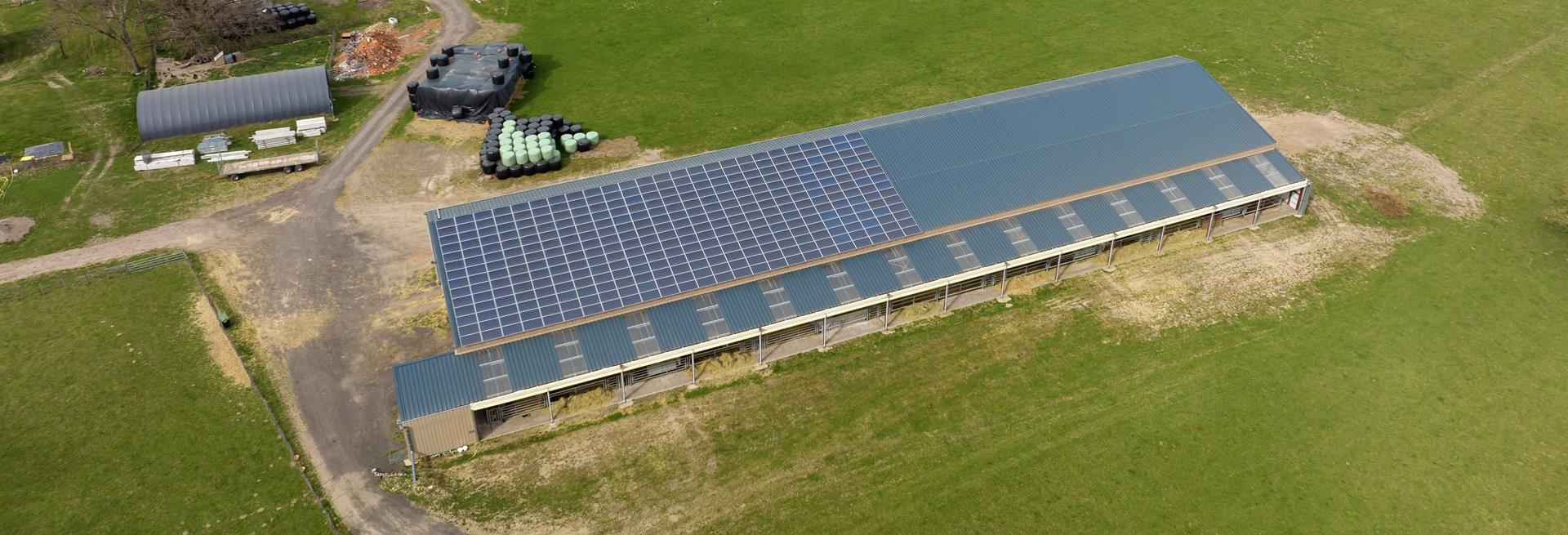
Solar back in the spotlight as farmers and landowners seek to mitigate energy crisis
Mon 17 Oct 2022
UK inflation hit 10.1% in July 2022. This is the first time inflation has increased beyond 10% since the 1980s. Of course, this figure is the only national average, covering all sectors, and does not highlight the fact that inflation in the agricultural sector 'agflation' is reported to be at over 20% year on year, and rose to as high as 30% in April. This high inflation started with disruption during the global economic emergence from the Covid-19 pandemic, and is more recently driven by the conflict in Ukraine, both of which have put pressure on fuel, gas, fertiliser and electricity prices.
Despite the removal of government subsidy for export of solar power to the national grid via the Feed in Tariff (FIT) on the 1st of April 2019, small scale roof and floor mounted, solar arrays have been a sensible business investment for those that can afford it, typically providing a 10 year payback and protecting businesses against shocks in the electricity market. However, in the current market of rapid inflation, solar arrays are back in the spotlight as an essential investment for any business with a significant power demand, as they displace expensive power imports and, depending on the size of the array, can provide a revenue via sales of excess power to the grid.
For context, before recent inflation, imported power was costing businesses in the region of 12 – 15p/kwh and businesses with solar arrays could expect to receive circa 4 – 6 p/kwh for any excess power that was “spilled” to the grid. This pricing meant that solar arrays were typically designed such that around 80% of the generated power was consumed onsite, with 20% being exported to the grid. The low export price made it uneconomical for businesses to install solar arrays for which financial returns relied on revenue generated from excess power being sold to the grid, and the emphasis was purely on displacing standard baseload demand.
In today’s market, although the case remains that sales to the grid should not be relied on as the primary source of project returns, inflation in both the import price of power purchased from the grid and the export price of power sold to the grid have reduced project payback periods from around 10 years, to closer to 5 or 6 years. Furthermore, the high export price is shifting industry standards as solar developers design larger systems that generate more surplus power to sell to the grid.
Whether it be a high price market, or a low price market, any business considering installing a solar array should fully analyse its power usage data and design a system that provides at least enough power to supply its baseload requirements, plus an amount of excess capacity that reflects the businesses’ attitude towards risk on future sales of power exported to the grid.
Market sentiment is that, in the long term, power pricing will fall back at least to pre-crisis levels, and possibly even further as more renewable energy is commissioned, and the impact of war in Ukraine lessens. However, the medium term 2 – 5 year outlook is that high pricing is here to stay, meaning that some businesses are still choosing to install arrays with a higher level of power export, while returns are good. This allows businesses to benefit from higher returns in the short term and if, in the long term, prices do fall, the business will have already made its’ return and the larger solar array will remain in place to protect the business against future shocks in the power market.
Businesses with greater incentive to shield themselves from the power market, either because they have a particularly high-power demand or because electricity makes up a high proportion of their costs, e.g. potato stores or vertical farms, are considering adding batteries to their solar installations. The progress of battery technology, along with current electricity price highs mean returns from battery installations are becoming more attractive, although they are not appropriate in every case. Batteries can store any excess daytime electricity generation, for use during the night, or, batteries can be charged at times when power prices are low, using power from the grid. This stored power is then discharged at times of the day when the solar array is not generating enough power to fully supply a site, or, sold back to the grid at a higher price than it was purchased for.
As with many industries, the global supply chain for solar hardware is in a state of disruption at the moment, with lead times on certain pieces of equipment emphasising the point that any business looking for a respite from higher power pricing should be engaging with developers sooner rather than later. As is to be expected, this supply chain disruption has been followed by increases in the costs of solar installations but despite this, a well-designed system that is specified to suit the requirements of a business should still be a good investment.
As well as the financial benefits of solar, clearly, businesses installing solar arrays will benefit from the carbon credentials that come with offsetting non-renewable power consumption with a renewable alternative. If a site is open to the public e.g. a farm shop, then most solar developers will be able to install a display screen that shows, in real time, the amount of non-renewable power that is being offset and the KGs of CO2 equivalent that is being saved by the investment - good PR for any public facing business.
For more information on this topic, please contact Josh Crick on josh.crick@brown-co.com or on 07768 142925.
Keep updated
Keep up-to-date with our latest news and updates. Sign up below and we'll add you to our mailing list.
 Brown&Co
Brown&Co



